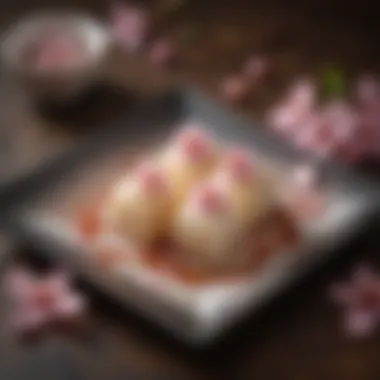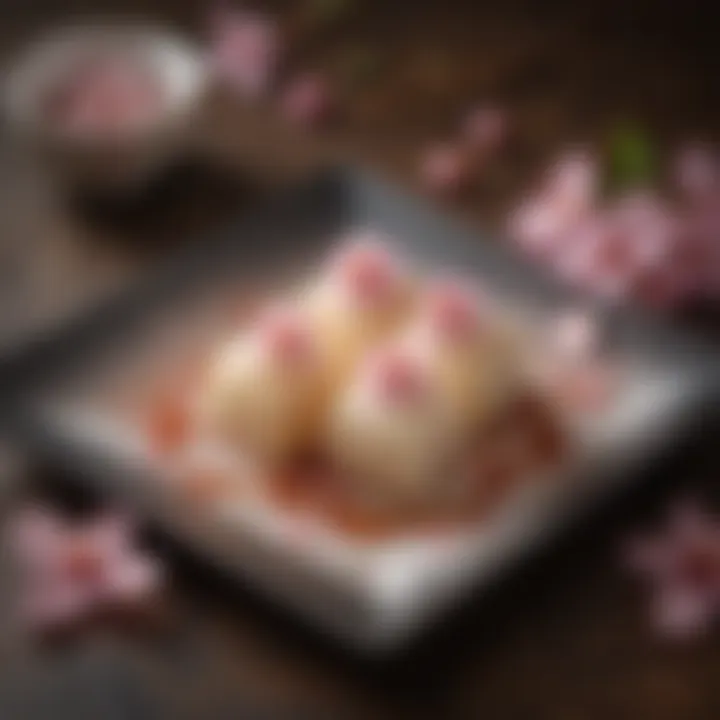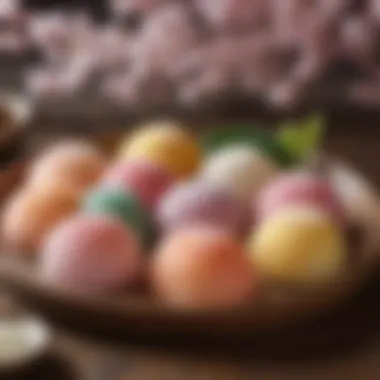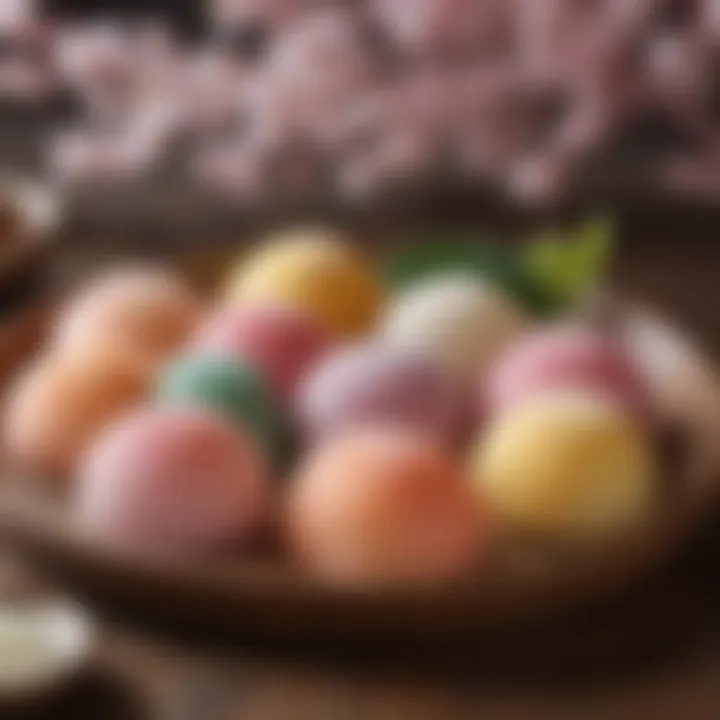Exploring Sakura Mochi: The Essence of Japanese Confectionery


Intro
Sakura mochi, a delicacy deeply rooted in Japanese culture, represents more than just a sweet treat. It embodies a connection to nature, particularly the fleeting beauty of cherry blossoms. Each bite resonates with seasonal traditions and culinary artistry. This article aims to explore the nuances of sakura mochi, shedding light on its historical significance and the rituals surrounding it.
Recipe Overview
- Name: Sakura Delight Mochi
- Yield: 8 portions
- Time Required: 40 minutes (20 minutes prep, 20 minutes cooking)
- Difficulty: Medium
Main Ingredients
- Sweet rice flour (also known as mochiko)
- Water
- Sugar
- Red bean paste (anko)
- Cherry leaves (pickled in salt)
- Food coloring (optional, for aesthetics)
Step-by-Step Instructions
- Prep the Leaves: Begin by soaking the cherry leaves in water to moderate the saltiness. This might take about 10 minutes.
- Prepare the Dough: In a bowl, mix sweet rice flour, sugar, and water. Stir the mixture until smooth and homogeneous.
- Cook the Dough: Transfer the bowl to a steamer. Cover and steam for 10 minutes. This allows the dough to achieve a slightly sticky texture, characteristic of mochi.
- Cool Down the Dough: Once cooked, remove the dough from the steamer. Let it cool briefly until it is manageable.
- Shape the Mochi: Dust your hands with cornstarch to prevent sticking. Take about a tablespoon of dough, flatten it, and wrap around a small amount of red bean paste. Seal the edges tightly to form a ball.
- Wrapping: Take the soaked cherry leaves and wrap each mochi ball in a leaf. The leaf adds a distinct aroma that further elevates the overall flavor.
- Serve: Optionally, chill the wrapped mochi in the refrigerator for a short while before serving. This enhances the flavor experience as it's often enjoyed cold.
Nutritional Information
- Calories per portion: Approximately 120 calories
- Macronutrient Breakdown:
- Proteins: 2g
- Fats: 0g
- Carbohydrates: 28g
Beneficial Nutrients
Sakura mochi includes sweet rice flour, which is gluten-free and easier to digest. The red bean paste provides fiber, contributing to digestive health.
Quick Cooking Tips
- Utilize a steamer basket if you don't have a covered pot. It can be efficient and minimizes cleanup.
- Cook several batches at once to save time. Create variations by adding flavors to individual portions.
- If you seek a quicker method, try microwaving the mochi dough in 1-minute intervals, stirring in between.
Related Recipes & Variations
Consider making matcha mochi or seasonal fruit mochi as diversions from sakura mochi. Each variation can bring new flavors while rescuing the essence of patriotic celebration.
Dietary Adaptations
- For vegan options, ensure vegan red bean paste is used.
- Substitute red bean paste with fruit jam for a sweet and fruity alternative.
Sakura mochi transcends its culinary role, serving as a reminder of the ephemeral beauty of cherry blossoms. It is not just consumed but tasted with mindfulness, preserving the harmony of tradition and modern-day adaptations.
Prolusion to Sakura Mochi
Sakura mochi is a delicacy that transcends simple confectionery. It serves as a culinary treasure in Japan, intricately connected to cultural rituals and seasonal festivities. This section emphasizes why understanding sakura mochi lays the framework for appreciating its broader historical and culinary contexts.
Sakura mochi combines distinctive flavors, notable preparation techniques, and historical roots. The sweet encapsulates cherry blossoms, aligning with Japan's aesthetic values and seasonal changes. Recognizing this cultural panorama not only caters to culinary enthusiasts but actually deepens their gastronomic knowledge.
Defining Sakura Mochi
Sakura mochi is a traditional Japanese sweet made primarily from sticky rice and sweet red bean paste. It is typically wrapped in a pickled cherry blossom leaf, which adds a unique flavor profile. The most common form of sakura mochi is Kanto-style, where the rice dough is pink, resembling a sakura blossom. In contrast, Kansai-style features a more round and green rice cake, often filled with red bean paste but without the visible greenery.
The distinctive features of sakura mochi are tied not just to the ingredients but also to its wrapping. The addition of the cherry blossom leaf brings a touch of umami and a unique visual appeal. This intertwines culinary craftsmanship with natural elements, creating a multi-sensory experience that reflects careful artisanship. By defining sakura mochi in these terms, one obtains a richness that is absent in many other Asian desserts.
Cultural Significance
Sakura mochi is enmeshed with Japan's rich tapestry of traditions. Its history is steeped in Hanami - the practice of relishing the beauty of cherry blossoms during spring. It is primarily enjoyed during the Doll Festival, known as Hinamatsuri, celebrated on March 3rd each year. Families offer sakura mochi to their daughters as a symbolic wish for happiness and health.


Moreover, sakura mochi acts as a representation of transience, an essential theme in Japanese culture. The fleeting nature of cherry blossoms echoes the ephemeral quality of life itself. Thus, sakura mochi is more than just food; it embodies heartfelt emotions, seasonal symbolism, and a deep respect for nature.
Historical Context
Understanding the historical context of sakura mochi provides deeper insight into its significance in Japanese culture. This is not only about the confection but encompasses the traditions and values woven into its existence. Learning its background can reveal how food acts as a bridge between the present and collective cultural heritage. Sakura mochi embodies the spirit of Japan through its linked festivals and distinct ingredients.
Origins of Sakura Mochi
Sakura mochi has roots tracing back centuries, particularly related to the festivities around cherry blossoms. This sweet is primarily enjoyed during Hanami, the cherry blossom viewing festival. The practice is said to have originated in the Edo period (1603-1868), where the spirit of sakura inspired many forms of art, including food. Traditional records highlight the connection between the bloom of cherry blossoms and the rich cultural symbolism it carries.
In essence, sakura mochi combines glutinous rice, red bean paste, and sakura leaves, such as those derived from the cherry blossom tree. The leaves lend their distinct flavor to the mushroom and add to its aroma. Interestingly, reports suggest that sakura mochi may have also evolved from ancient rice cakes that were offered during harvest rituals. These early forms symbolize fertility and prosperity, attributes deeply cherished in Japan.
Evolution Through Time
As with most cultural artifacts, sakura mochi has seen a steady evolution over time. In the past, its preparation was labor-intensive, deeply connected to the agricultural calendar and early harvesting traditions. Typically, locals would handpick sakura leaves during the bloom period to preserve their fragrance.
Throughout the Meiji era, sakura mochi began to diversify. Influences from western confectionery chefs began merging with traditional Japanese practices. This fusion intrigued many palates, leading to the introduction of novel flavor combinations. The debate on whether the confection should be chewy or more cake-like signifies ongoing dialogues about taste and texture.
Sakura mochi's acknowledgment grew across generations, eventually becoming a staple at seasonal festivals and modern events alike. Even today, artisans in Japan continually seek fresh perspectives, bringing a sense of artistry to the crafting of sakura mochi. Emphasis on sustainable, seasonal ingredients resonates with modern sensibilities, proving that history does not only inform but continually reshapes cultural expressions.
Ingredients in Sakura Mochi
The significance of the ingredients used in sakura mochi cannot be overstated. These components not only contribute to the flavor and texture of the sweet, but also hold deep cultural value. Understanding the ingredients is crucial for both culinary enthusiasts and those aiming to appreciate traditional Japanese sweets on a deeper level.
Traditional Ingredients
Sakura mochi is primarily made using a few key ingredients: sweet rice, red bean paste, and sakura leaves. The use of sweet rice, also known as glutinous rice, is integral to achieving the unique chewy texture that characterizes the mochi. This rice is stickier than regular rice, making it ideal for creating the desired consistency.
Red bean paste, or anko, serves as the primary filling. It has a mildly sweet taste that perfectly balances the flavor of the mochi. Typically made from adzuki beans, it is prepared by boiling the beans, then mashing them and adding sugar. The quality of the red bean paste can greatly influence the taste of the final product.
Sakura leaves, often pickled, add a distinctive fragrance to the sakura mochi. They are not just for decoration; their salty taste complements the sweetness of the rice and the red bean paste. This combination creates a harmonious blend both in flavor and sensory experience.
Regional Variations
Regional variations of sakura mochi highlight how ingredients can differ across Japan based on local tastes and agricultural products. This diversity allows each variant to carry its own story.
Different Rice Types
In some regions, cooks might experiment with different rice types. More traditional variations strictly stick to sweet or glutinous rice, valued for it's texture. However, choices like mochi rice or non-glutinous rice have made appearances. Non-glutinous rice can yield a different texture—less chewy, more crumbly.
Regardless of type, certain rice approaches may be popular for their effectiveness in achieving fried textures when toasted semi-dry before use in mochi.
Flavoring Agents
Flavoring agents extend beyond the basic ingredients. Some cooks might incorporate matcha or local fruits to introduce non-traditional yet innovative flavors. Matcha infuses a rich umami quality to the sweet, while fruits like strawberry may give unique seasonal appeal. Personal preference can greatly influence choice in flavoring agent, thus catering to different palates.
However, while exploring these flavors, it is crucial to keep the essence of the sakura mochi intact. Excessive innovation can stray too far from the dish's primary character. The balance here is key.
Preparation Techniques
Preparing sakura mochi requires a careful balance of technique and cultural respect. This dessert is not simply made; it is a process that echoes traditional methods, ensuring authenticity. When focusing on preparation techniques, one must consider the ingredients' nuances, the timing of their incorporation, and the critical cooking methods tailored to different components. Each step in the preparation plays a vital role in the final taste and presentation of the sakura mochi.
Step-by-Step Guide
To make sakura mochi successfully, follow this detailed process:
- Gather your ingredients: You need sweet rice (mochi rice), red bean paste, sakura leaves (often pickled), and sugar.
- Prepare the rice: Soak the sweet rice in water for at least four hours. This hydration helps achieve that sticky texture essential for mochi.
- Steaming process: Drain and transfer the soaked rice to a steamer. Steam it for approximately 30 minutes. You can check if it’s fully cooked by tasting—it should be sticky yet firm.
- Make the filling: While steaming the rice, prepare your sweet red bean paste. If you want, you can manufacture it at home by cooking adzuki beans until soft and then blending them with sugar prior to cooling.
- Forming the mochi: Once the rice cools slightly but is still warm, mix it with sugar. Using hands dusted with cornstarch, roll the rice into small circles. Each piece should be enough to cover a ball of red bean paste comfortably.
- Wrapping: Take a piece of the cooked rice and flatten it. Place the red bean paste inside and shape it into a ball, ensuring it is sealed properly.
- You can now wrap each mochi with a sakura leaf. This adds not only flavor but a beautiful aesthetic.
- Final chilling step: Refrigerate the prepared sakura mochi for around a couple of hours. This ensures they hold their shape before serving.


Utilizing cohesive step-by-step guide assures you of both authenticity and taste, essential for truly experiencing sakura mochi.
Common Mistakes to Avoid
Despite the apparent simplicity, there are several common errors that people make when preparing sakura mochi. Here are some key pitfalls to avoid:
- Not soaking the rice long enough: Insufficient soaking can lead to graininess and improper texture.
- Overcooking or undercooking the rice: Each rice grain should be sticky yet firm. Monitor the chopping intervals during steaming closely.
- Ignoring ingredient measurements: More sugar or too little can disrupt balance in flavor.
- Failing to cool the rice properly: This could hinder your ability to mold the mochi well. Cooling slightly is crucial.
Remember, mastery of preparation techniques enhances both the taste and experience of sakura mochi.
Sakura Mochi Variants
Sakura mochi is not just a singular confection but a representation of Japan's diverse regional and modern culinary expressions. Examining the variants of sakura mochi offers insights into regional tastes, traditions, and even innovation in Japanese pastry. Each variant tells a story deeply rooted in its locale, reflecting how cherry blossoms influence not only flavors but also the festivals and manners of enjoyment surrounding the treat.
Regional Differences
The sakura mochi journey varies significantly across Japan. Predominantly, there are two styles: Kanto and Kansai.
Kanto sakura mochi, often characterized by its broad, flat shape, typically uses a layer of sweet red bean paste wrapped in a thin rice cake. This version may present a more recognized taste among those familiar with Japanese desserts, often accented with a salty sakura leaf to amplify layers of flavor. Meanwhile, Kansai sakura mochi showcases a thicker, rounder sushi-like form, where a modicum of sweet red bean filling often gets enveloped with a firmer, glutenous rice layer. In these forms, rice flour plays a central role, creating different textures while maintaining that traditional essence.
Sakura Mochi in Contemporary Culture
Sakura mochi holds a unique position in modern Japanese society, bridging tradition and the contemporary culinary landscape. Its embodiment of Japanese culture reflects both aesthetic and experiential dimensions during key seasonal festivities. Understanding sakura mochi's role in the present day gives critical insight into how traditional foods adapt while remaining rooted in cultural significance.
Seasonal Festivals
Sakura mochi finds its prominence particularly during hanami, the cherry blossom viewing season, which celebrates the ephemeral beauty of sakura. Traditionally, families and friends gather in parks under cherry blossom trees to share food and enjoy fleeting beauty of flowers. Sakura mochi serves not just as a treat but also as a social marker, promoting connections between loved ones.
It typically appears in various festivals, symbolizing renewal and the arrival of spring. The wrapping of the rice cake in a salted cherry blossom leaf enhances its flavors while also integrating another cultural aspect. Festivals are a chance to deepen understanding of nature and cultural identity through shared culinary experiences.
During Kodomo no Hi, or Children’s Day, sakura mochi continues its legacy, often made in vibrant variations to symbolize good fortune and health for children. This continuous association ties sakura mochi to joy and celebration, reinforcing the ancient legends tied to the confection.
Current Commercialization
In recent years, sakura mochi has experienced commercialization that has introduced it to wider audiences beyond Japan. The global interest in traditional Japanese sweets leads to more brands like grocery stores or cafés including sakura mochi on their menus, thus elevating its profile. The ingredient innovation further adds layers to its traditional essence.
Modern interpretations blend flavors beyond the conventional. For instance, incorporation of ingredients like matcha or black sesame gives contemporary paradigms while respecting the original identity. Products such as pre-packaged sakura mochi are designed for easy access, catering to busy lifestyles.
However, commercialization raises concerns over authenticity. Customers debate the merits of traditional versus modernized versions, challenging artisans to navigate between maintaining heritage and meeting contemporary tastes. Yet, such developments play a critical role in preserving a culinary tradition.
The blend between modern commerce and cultural wisdom provides an opportunity for deeper engagement with traditions in global landscapes.
Sakura mochi does not merely serve as a culinary delight, but as a prism reflecting the changing cultural narratives. Observations of how it integrates into modern life demonstrate its rising importance as both a symbol of nostalgia and innovation. Each bite transcends mere flavor—it invokes stories, connections, and the enduring nature of Japanese storytelling.
Culinary Pairings
Culinary pairings play a critical role in enhancing the overall experience of sakura mochi. When enjoyed with complementary foods and beverages, the flavor profile of this traditional sweet can be elevated in significant ways. Understanding the nuances of pairing can lead to a more satisfying and culturally resonant culinary experience. The right combinations enhance the delicate sweetness of sakura mochi while also introducing contrasting flavors that can make for a well-rounded tasting experience.
Beverage Pairings
The selection of beverages to accompany sakura mochi is not trivial. Teas are often the first choice given their subtle flavors and cultural associations. Matcha, a finely ground green tea, is a traditional and popular option. The earthy notes of matcha provide a pleasant contrast to the sweet and floral flavors of sakura mochi.
Other excellent beverage options include:
- Sencha: This type of Japanese green tea offers a refreshing profile that balances the sweetness.
- Umeshu: A sweet and fruity plum wine, which brings a unique tartness that can enhance the overall tasting experience.
- Carbonated drinks like sodas can also serve as an interesting alkaline offset to the sugariness of the mochi itself.
Beverages that are frothy or creamy may not pair as well, as they can overwhelm the delicate flavors found in sakura mochi. It is advisable to choose lighter flavors that can either complement or contrast gently without stealing focus from the mochi.


Serving Suggestions
Presenting sakura mochi respects its cultural heritage and enhances the overall experience. One method involves serving it on a traditional wooden or ceramic plate. This allows the visual beauty to shine through and connects diners with an aesthetic that is deeply rooted in Japanese traditions.
Another popular serving suggestion is using leafy greens, particularly sakura leaves. The aromatic leaf can be an essential touch. It brings an extra layer that honors tradition while also adding a slight herbal counterpoint.
Also consider positioning the mochi alongside slices of seasonal fruits such as strawberries or citrus. This aids in drawing sophistication and balance into the presentation.
To summarize: there are splendid options for beverages and attractive ways to serve sakura mochi that can make any occasion feel culturally immersive and visually delightful.
The ability to harmonize flavors while respecting cultural heritage defines the core of culinary pairings.
Nutritional Analysis of Sakura Mochi
Understanding sakura mochi's nutritional profile is important not just for culinary enthusiasts but also for those keen on appreciating its cultural depth. Sakura mochi is often perceived as a delicate dessert, but it infuses traditional cooking with nutritional elements. This section dives into its caloric composition and the health benefitts, as well as frameworks for keeping a well-rounded diet.
Caloric Content
Sakura mochi is relatively low in caloric content, depending mainly on its ingredients. A typical serving size of sakura mochi can range from 100 to 120 calories. The caloric content is primarily sourced from** glutinous rice** and sweet bean paste; both components provide the majority of the energy. Adjustments in portion size or the ratio of filling can influence the overall calorie count significantly.
Here are some key points regarding the caloric composition:
- Glutinous Rice: This is the foundation of sakura mochi, and about a third of the caloric content comes from it. Rice provides essential carbohydrates necessary for energy.
- Sweet Bean Paste: Traditionally made from azuki beans, the paste dentists its sugar, which ensures a rich, satisfying flavor. This adds to the caloric amount as well, making an enjoyable experience without excessive indulgence.
- Sakura Leaves: Though included mainly for aroma and flavor, some variations might add caloric count marginally but not significantly.
Thus, when enjoying sakura mochi, one can find it reasonable for a sweet treat while maintaining balancingit in their overall diet.
Health Benefits and Drawbacks
Sakura mochi, like many traditional sweets, presents an intriguing consideration body’s needs and potential health impact. Below are some of the health benefits along with possible drawbacks of consumption:
Benefits:
- Natural Ingredients: Primarily made from rice and beans, sakura mochi contains wholesome ingredients with less artificial additives compared to many modern sweets.
- Cultural Experience: Consuming sakura mochi can offer a sense of cultural appreciation and connection to Japanese traditions, contributing to mental well-being through cultural engagement.
- Regulated Sugar Levels: Compared to other confections, sakura mochi possesses lower sugar levels, making it a decent option for those examining their sugar intake moderately.
Drawbacks:
- High Carb Content: While it made of easier ingredients, those vigilant of carbohydrate intake might want to be cautious, especially with glucose levels regulated as necessary for personal health.
- Allergenic Components: Glutinous rice might not suit persons with gluten intolerance, despite cornoper showing resemblance, fragrant variety being interesting as older but few should trace values claimed as gluten-containing.
Overall, while enjoying sakura mochi, moderation remains crucial. It embodies both culural and nutrional joy when consumed thoughtfully in various celebratory or reflective experiences. The interplay of flavors also connects back to its roots; knowledge of content contributes greatly whenever selecting an indulgence food as part of embedding staple experience.
Sakura mochi should be embraced as part of a balanced diet, tracing roots alongside personal preferences.
Culmination
Sakura mochi is not merely a dessert; it's a reflection of Japanese culture, history, and seasonal celebrations. Its integration into the annual festivities showcases its importance beyond taste. In this article, we analyzed various elements: historical significance, preparation techniques, and its changing role in modern society. By examining these aspects, we understood that sakura mochi serves as a bridge between the past and the present.
The cultural and culinary insights provided herein highlight several benefits of deeper exploration into sakura mochi:
- Cultural Heritage: Understanding the mochi's cultural roots reinforces appreciation for tradition.
- Culinary Techniques: Gaining insight into preparation methods can enhance cooking skills.
- Health Considerations: Being aware of nutritional aspects allows for informed choices.
Through this discourse, we recognize sakura mochi as more than a simple confection. Instead, it embodies dignity, flavors, and how food connects to community and identity in Japan. Each bite of this sweet delicacy carries the beauty of cherry blossoms and an enduring respect for a time-honored custom.
"Sakura mochi encapsulates both flavor and experience, serving as a joyful element within Japanese culture."
Thus, sakura mochi's journey from traditional roots to modern adaptations serves as a constant reminder of cultural continuity and culinary innovation.
Final Thoughts on Sakura Mochi
As festivals unfold annually under blooming cherry trees, sakura mochi emerges as a central component on tables. What makes it noteworthy is not just its flavor but its symbolism. It represents people's connection to history through a celebration of nature's transient beauty.
From making it at home to finding it at festivals, exploring sakura mochi elevates one's understanding of Japan's culinary landscape. Each locale imparts its uniqueness through different variations, ensuring that adaptation keeps the tradition alive while broadening its audience.
Ultimately, through embracing and savoring sakura mochi, one engages in a cultural narrative worth preserving, reliving, and sharing.







